Table of Contents
Do you want to learn to exercise with resistance bands, move your bodyweight training to a more advanced level or diversify your gym routine? We have a solution for you in the form of resistance bands or expanders. These are exercise aids that are suitable for full-body training. They exist in many variants with different levels of resistance, so both beginners and advanced can use them. Therefore, everyone will find the one corresponding to their current condition and goals.
You can take resistance bands anywhere, which is one of many benefits of this training aid. You can use them, for example, at the street workout park or for a quick workout on vacation. You won’t have to skip your favourite strength training even if you don’t have a gym available.
There are many ways to use resistance bands in your training. You can attach the longer ones to the crossbar or other solid construction and target your arm and back muscles. Shorter bands are better for placing on your feet, adding some resistance in squats and other exercises. You can do most of the exercises below even at home.
Today’s article offers 30 resistance band exercises divided according to mainly targeted muscle groups. Thus, you will work on your arm, back, ab, butt and thigh muscles. Every exercise in the list includes the explanation fo the correct technique, and there is a sample full-body workout at the end of the article.
If you also want to support your efforts with nutrition, don’t forget about a quality diet. The article A Simple Guide on How to Count Calories and Achieve Your Goals will help.
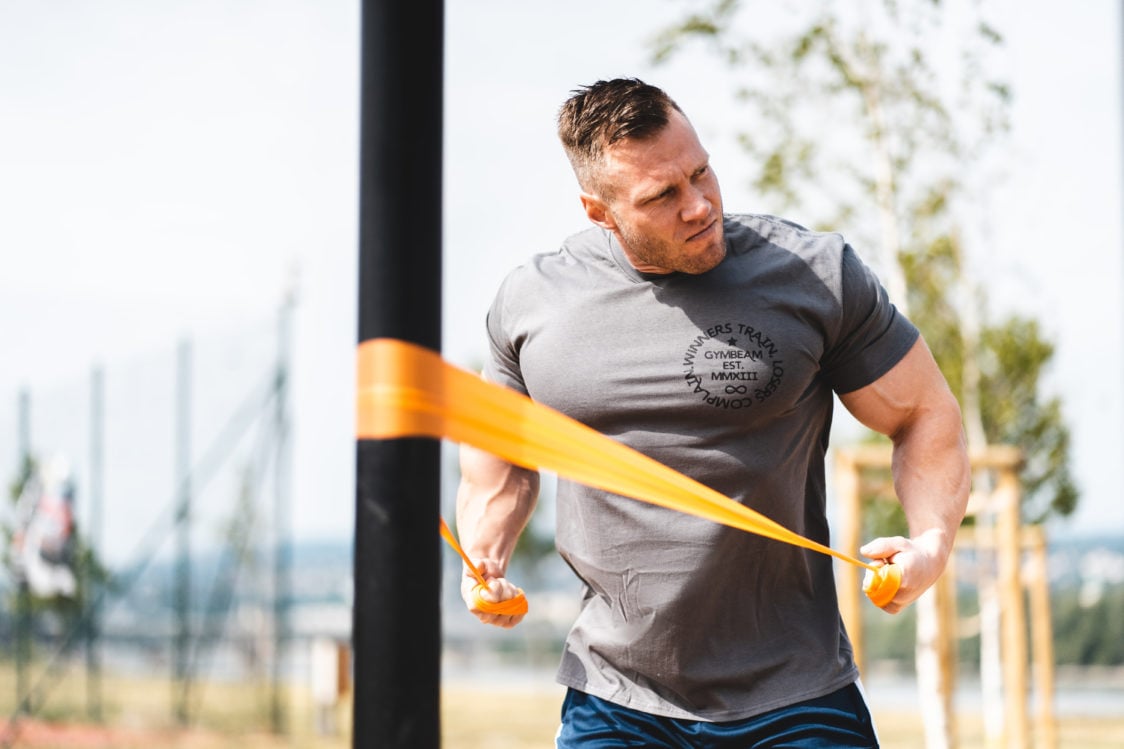
List of 30 Effective Resistance Band Exercises
All you need for these exercises is a long loop resistance band, or a tightly tied resistance band. You will also use a shorter loop resistance band. It is ideal to have different types of expanders on hand. That allows you to increase and decrease the load as needed.
If you are a beginner and do not yet feel like lifting heavy weights, you can use resistance bands to diversify your bodyweight training. It is suitable for squats, lunges, crunches and other exercises that you probably already know. It will give your body a new impetus and take your training to the next level.
You can also compile training from these exercises if you are an advanced athlete. Make up a new training routine or use exercises for the upper or lower body workouts. This will help you diversify your training program and give your muscles a new incentive to strengthen and grow.
Before you start training, find a solid structure, such as a crossbar and attach the resistance band to it. Remember to warm up before every training (running on the spot or skipping rope). Then warm up your large joints in a circular motion. After the main part, take a few minutes to stretch.
When exercising with resistance bands, focus on the correct technique and keep your core activated. The movement should be controlled and try to reach a full range of motion.
Butt and Leg Exercises
Thanks to these exercises, you will strengthen the buttocks and, at the same time, the front, back, and inner thighs. In addition, most exercises are complex (multi-joint) allowing you to engage the muscles of the almost entire body.
1. Front Squat
- Starting position: Stand with your feet shoulder-width apart. Step on one end of the resistance band and pull it over your head on the neck. Keep your back straight and your head in line with the spine.
- Performance: Inhale and do a squat by moving the pelvis back and down. Beware of the rounding of the back in the lumbar and thoracic spine. Choose a squat depth in which you can keep your spine straight naturally. The axis of the knee, ankle and toe should remain in one place. When moving down, you can extend your arms forward for better stability. Smoothly return to the starting position by activating the front of the thighs while exhaling. Then do the next rep.
- Common mistakes: Bent back, a small range of motion, bending forward, the knees point inwards, unevenly distributed weight, the weight shift to the tiptoes or heels.
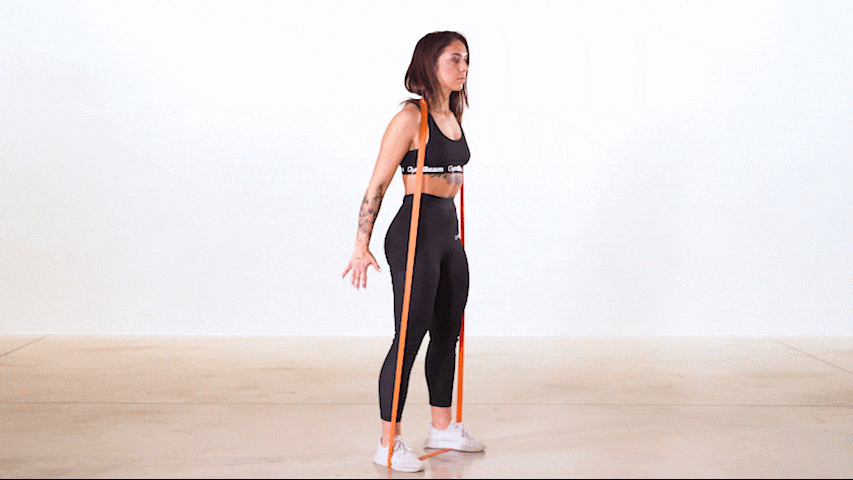
2. Leg Extension
- Starting position: Attach the resistance band to the top of the crossbar with one end. Wrap the opposite end around one ankle. Stand a few meters in front of the crossbar. Stand with your feet hip-width apart. Slightly bend your knees. Put your hands on the hips and activate the core (diaphragm, abdominal, back, and pelvic floor muscles). Keep your back straight and your head in line with your spine.
- Performance: Extend and straighten your leg forward (the one with the band on). Then return to the starting position while inhaling. Lightly touch the floor with your foot, and move on to the next rep. Perform the set on one leg first and then on the other.
- Common mistakes: A small range of motion, the knees point inwards, uncontrolled movement.
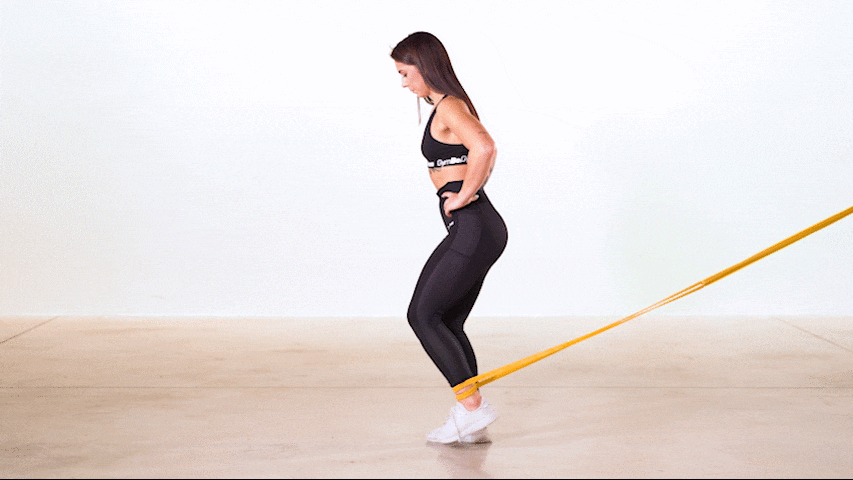
3. Hamstring Curl
- Starting position: Attach the resistance band to the top of the crossbar with one end. Wrap the opposite end around one ankle. Lie on your stomach on the exercise mat. Bend your arms next to your body and place your palms on the floor.
- Performance: Extend your leg backwards and pull the ankle towards your chest while exhaling. You should feel the hamstring activation. Then move on to the next rep. Perform the set on one leg first and then on the other. The farther you are from the crossbar, the more demanding the exercise becomes.
- Common mistakes: A small range of motion, bent back, uncontrolled movement.
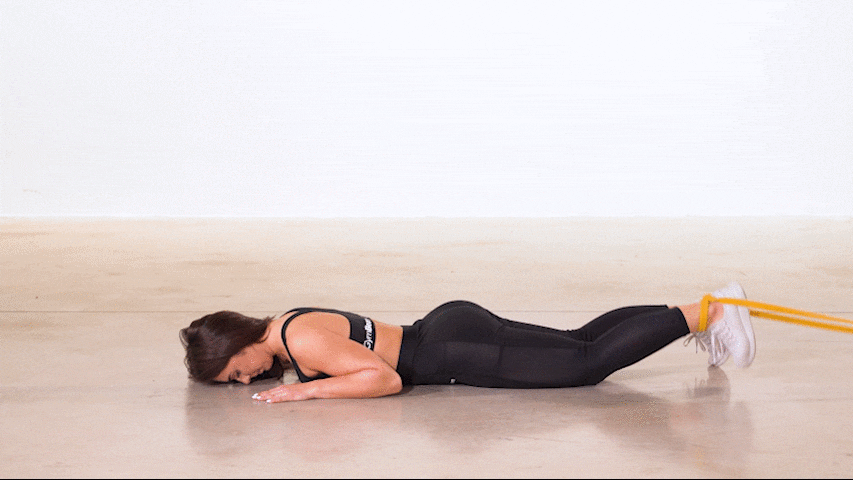
4. Glute Bridge
- Starting position: Place the resistance band above your knees. Lie on your back. Keep your head, upper back and arms on the mat. Bend your knees and pull them towards your glutes. You can leave your feet on the mat with the whole surface or lean only on your heels.
- Performance: Activate the glutes and core and raise your pelvis while exhaling. Raise it to the point where your knees, hips and shoulders are in line. You can remain in this position for 1–2 seconds. Then return to the starting position while inhaling and move on to the next rep. You can make the exercise more demanding by spreading your legs hip-width apart and putting them back together.
- Common mistakes: A small range of motion, bent back, uncontrolled movement, insufficient glute activation.
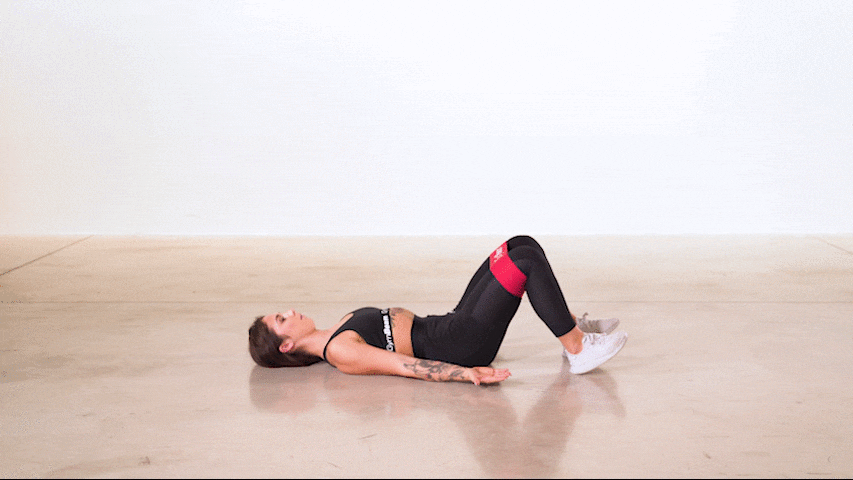
5. Side Squat
- Starting position: Attach one end of the resistance band to the lower part of the crossbar. Place the other one on your left ankle. Stand with your left side to the crossbar. The feet are next to each other hip-width apart, and arms along the body.
- Performance: Inhale, take a step to the side and simultaneously do a squat. Go as deep as where you can keep your back straight. The axis of the knee, ankle and tiptoe remains in line. Return to the starting position by activating the glutes and muscles of the front thighs while exhaling. Then move on to the next rep. Do one set on one side, then on the other.
- Common mistakes: Bent back, a small range of motion, bending forward, the knees point inwards, unevenly distributed weight.

6. Clamshell
- Starting position: Place the resistance band above the knees. Lie on the side. Rest your head on your bent arm and place the upper arm in front of the body (palm is on the mat). Bend your knees 90 degrees. The feet should touch one another during the whole exercise.
- Performance: Activate your glutes and spread your legs apart while exhaling. You can remain in this position for 1–2 seconds. Then return to the starting position while inhaling and move on to the next rep. Do one set on one side first, then on the other.
- Common mistakes: A small range of motion, uncontrolled movement, insufficient glute activation.
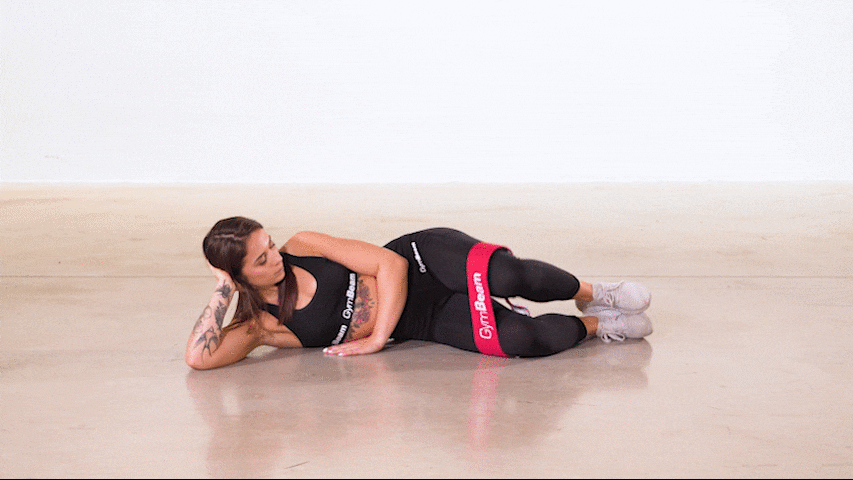
7. Reverse Lunge With Chest Fly
- Starting position: Grab the long expander with both hands by the ends and stretch your arms forward. Stand straight with your feet hip-apart.
- Performance: Inhale and do a reverse lunge with your right leg. Then do the torso rotation to the right side and simultaneously stretch your arms. Turn your arms and torso back while inhaling. Then return to the starting position while exhaling and do the same with the left leg.
- Common mistakes: Bent back, a small range of motion, bending forward, the knees point inwards, uncontrolled movement.
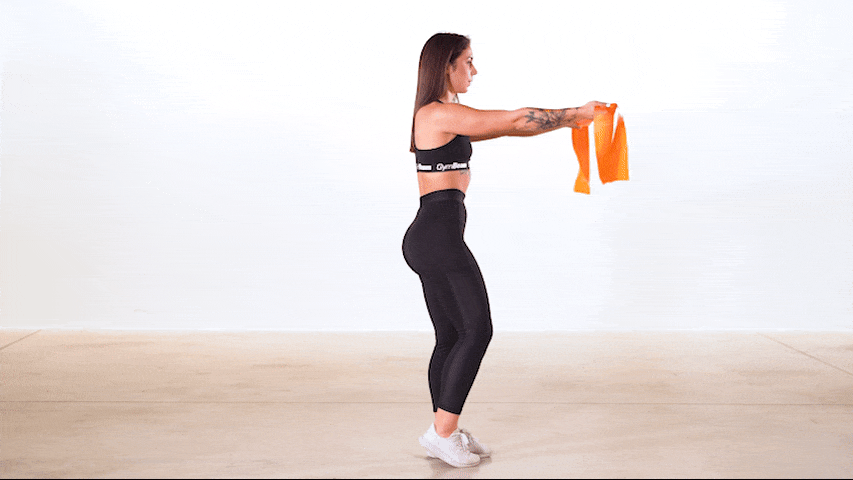
8. Side Walk
- Starting position: Place the resistance band on the ankles. Bend your arms and put your hands on your hips. You can slightly lean forward but try to keep your back straight. The knees are slightly bent, and the feet are shoulder-width apart.
- Performance: Brace your core and take a step to the right with your right foot. Then with the left foot. Then take a step to the left with your left foot, followed by a step with the right foot. Keep taking the steps until you finish the whole set. You can also take several steps to one side in a row, then to the other.
- Common mistakes: Bent back (in the lumbar area), a small range of motion, excessive forward bending, the knees point inwards, uncontrolled movement.
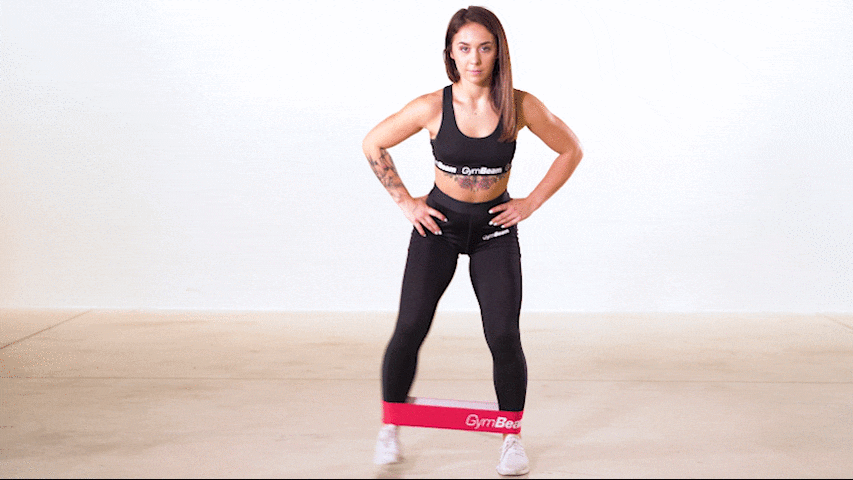
9. Standing Leg Abduction
- Starting position: Place the resistance band on the ankles. Bend your arms and put your hands on your hips. You can slightly lean forward but try to keep your back straight. The knees are slightly bent, and the feet are shoulder-width apart. Engage your core.
- Performance: Do a side leg lift while exhaling and put it back while inhaling. Then move on to the next rep. First, do one set on one leg, then on the other.
- Common mistakes: A small range of motion, excessive forward bending, bent back, uncontrolled movement.
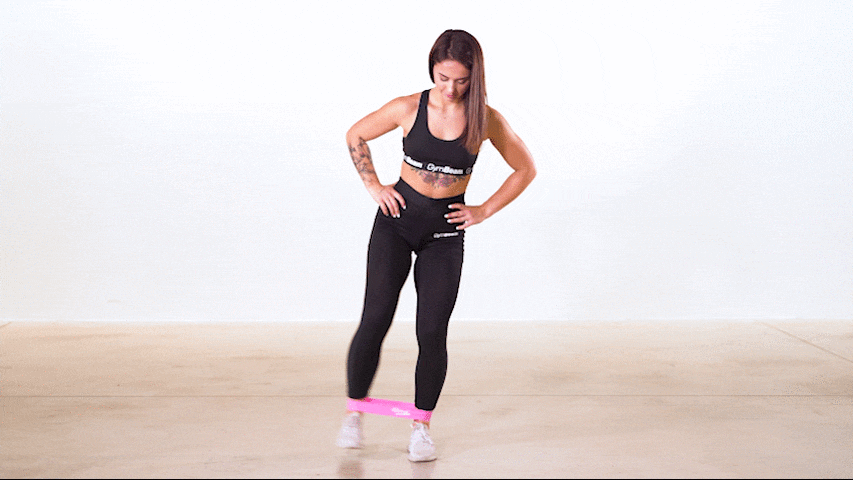
10. Seated Leg Abduction
- Starting position: Place the resistance band under the knees. Sit on the floor. Place your palms behind you and rest on them. Bend your knees and bring your feet closer to your butt.
- Performance: Activate your glutes and spread your legs apart while exhaling. You can remain in this position for 1–2 seconds. Then return to the starting position while inhaling and move on to the next rep.
- Common mistakes: A small range of motion, uncontrolled movement, insufficient glute activation.
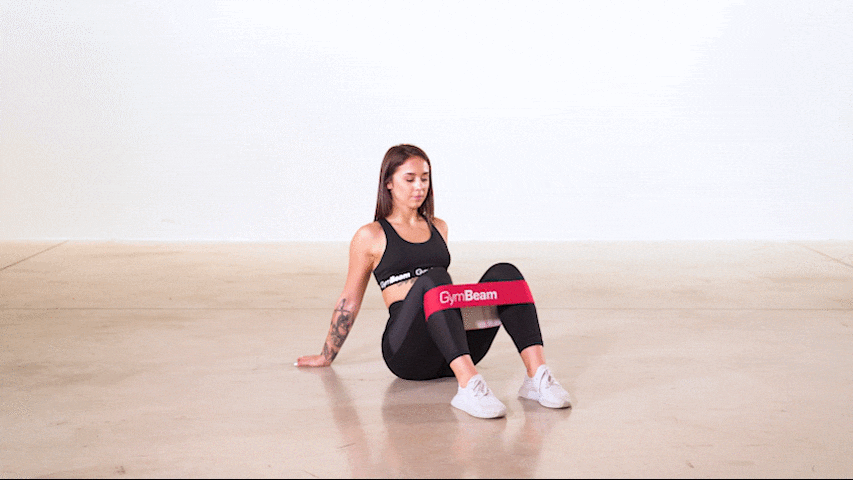
If you want to achieve bubble butt and lean legs, you should not miss our article How to Tone and Shape Your Butt and Legs.
You might be interested in these products:
Back Exercises
You can also work on your trapezius, broad back and interscapular muscles with the help of a resistance band. These exercises are also beneficial on the shoulders and arms. At the same time, you engage the core.
1. Bent-Over Row
- Starting position: Place the long resistance band on the floor and stand on the middle of it. Stand with your feet hip-apart. Slightly bend your knees, lean forward, and grab the ends of the resistance band with both hands. Keep your back straight, head in line with the spine and your shoulders back and down.
- Performance: Pull your arms toward your waist while exhaling and return to the starting position while inhaling. Pull the shoulder blades together on the way up.
- Common mistakes: A small range of motion, uncontrolled movement, bent back.

2. Seated Row
- Starting position: Sit on the ground with your legs extended. You can slightly bend your knees. Attach the long expander in the middle of its size by the feet. Keep your back straight, head in line with the spine, and shoulders back and down.
- Performance: Pull the band toward your waist while exhaling and return to the starting position while inhaling. Pull the shoulder blades together on the way toward the chest.
- Common mistakes: A small range of motion, uncontrolled movement, bent back.
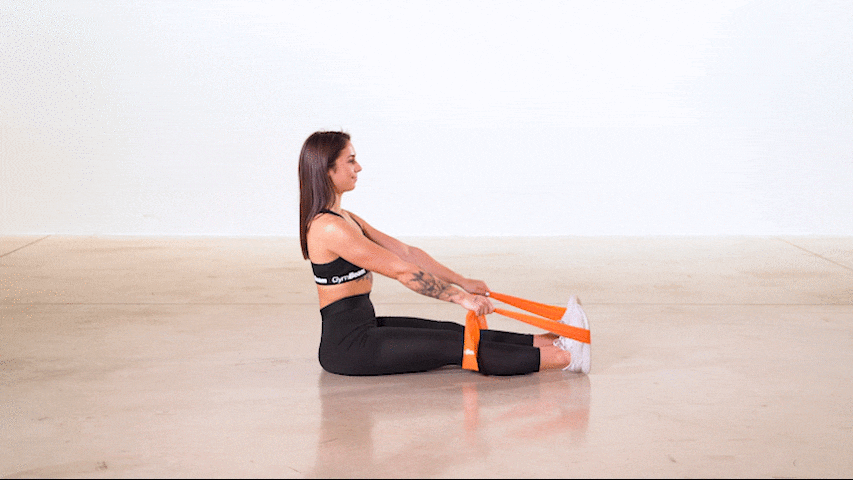
3. Standing Fly
- Starting position: Grab the long expander by both ends (underhand grip) and stretch your arms forward. Stand with your feet hip-apart. You can slightly bend your knees. Keep your back straight, head in line with the spine, and shoulders back and down.
- Performance: Activate your back muscles and stretch your arms forward while exhaling. The arms remain at the same height. Then return to the starting position while inhaling and move on to the next rep.
- Common mistakes: A small range of motion, uncontrolled movement, bent back.
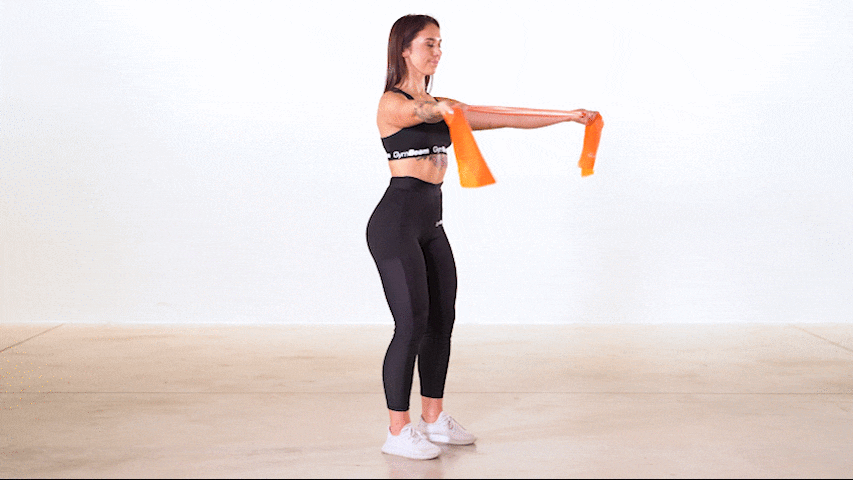
4. Lying Row
- Starting position: Attach one end of the long expander to the lower part of the crossbar. Lie on your back, stretch your arms upwards, and grab the band with your both hands. Keep the shoulders back and down and back on the mat during the whole time. Bend your knees.
- Performance: Activate your back muscles and hold your arms close to your body while exhaling. Return to the starting position while inhaling and move on to the next rep.
- Common mistakes: A small range of motion, uncontrolled movement, bent back.
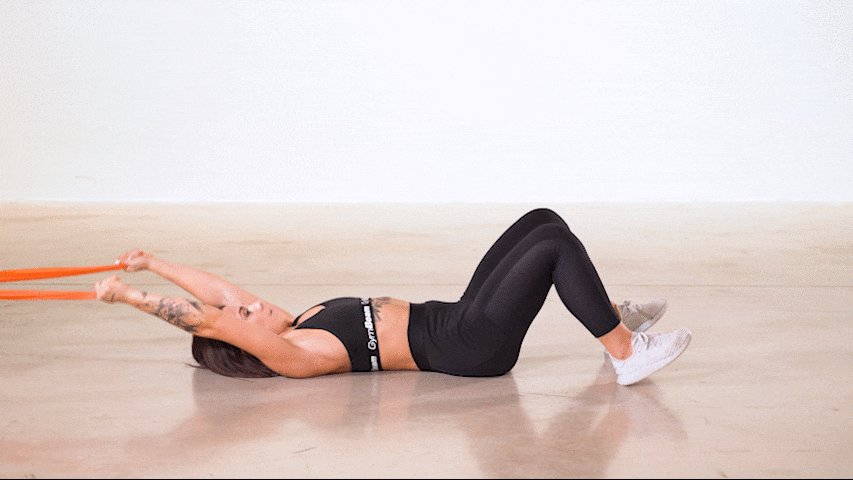
Chest Exercises
You can also effectively train the small and large pectoral muscles, forming the dominant part of the chest, with the help of a resistance band. You can use it to make push-ups more demanding or try a lying chest press.
1. Push Ups
- Starting position: Tie the expander over your back and place it under your shoulder blades. Then kneel on the floor, get to the high plank position (stretched arms) and place the other end of the band under your hands. Place the open hands under the shoulders wider than shoulder-width. Keep your shoulders back and down and shoulder blades together. The elbows should create an angle of 45 degrees with the body. Brace your core and try to keep your body in one line.
- Performance: Inhale, do a push-up and try to lightly touch the floor with your chest in the lower position. Then push the hands to the floor while exhaling, return to the starting position and move on to the next rep. You can also do knee push-ups, which is an easier option, doing the same movement.
- Common mistakes: A small range of motion, bent beck (especially in the lumbar area), unstable shoulder blades, the elbows pointing outwards.
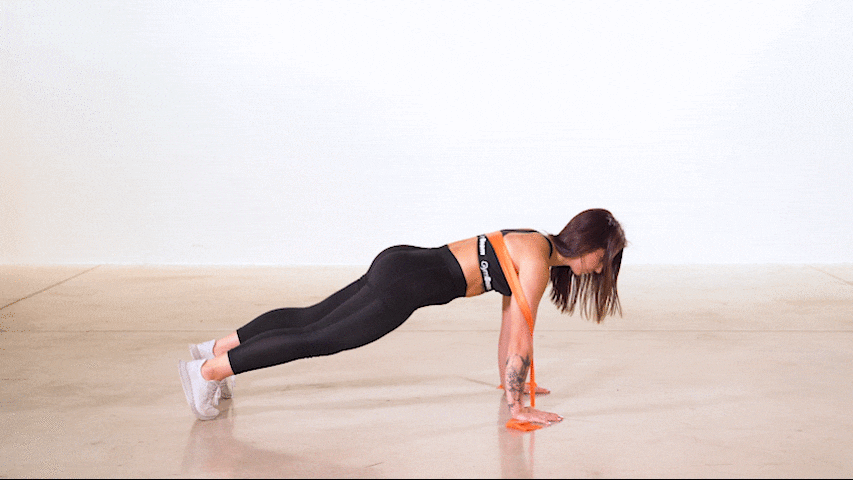
2. Floor Press
- Starting position: Place the expander on the floor. Lie on the back (the expander is under the shoulder blades). Grab both ends of the expander and bend the elbows 90 degrees. The forearms are perpendicular to the ground. Keep your shoulders back and down and back on the mat during the whole time. Bend your knees and pull your feet toward the glutes.
- Performance: Straighten your arms by activating the pectoral muscles while exhaling. Then return to the starting position while inhaling and repeat the movement.
- Common mistakes: The elbows point toward the body, bent back, uncontrolled movement.

Shoulder Exercises
You can also use a resistance band to diversify the shoulder workout. Expander shoulders exercises are similar to those with dumbbells. You will also involve the muscles of the arms and core.
1. Overhead Press
- Starting position: Place the long expander on the floor and step one end. Stand with feet hip-width apart. Grab the other part of the band with both hands, straighten your body and pull it over the chest. Bend your elbows. The palms point to the front. Keep the back straight, head in line with the spine, and shoulders back and down.
- Performance: Activate the arms muscles and stretch your arms upwards while exhaling. At the same time, push your head forward. Then carefully return to the starting position while inhaling and move on to the next rep.
- Common mistakes: A small range of motion, uncontrolled movement, bent back.
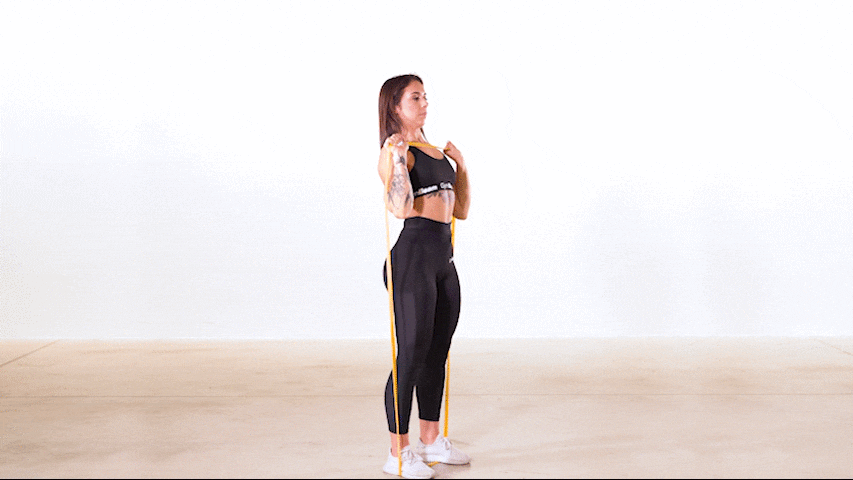
2. Arm Raises
- Starting position: Place the long expander on the floor and step one end. Stand with feet hip-width apart. Grab the other part of the band with both hands, straighten your body and pull it over the chest. Bend your elbows. The palms point to the body. Keep the back straight, head in line with the spine, and shoulders back and down.
- Performance: Activate the arms muscles and stretch your arms upwards while exhaling. Try to get your elbows to shoulder level. Then carefully return to the starting position while inhaling and move on to the next rep.
- Common mistakes: A small range of motion, uncontrolled movement, bent back.
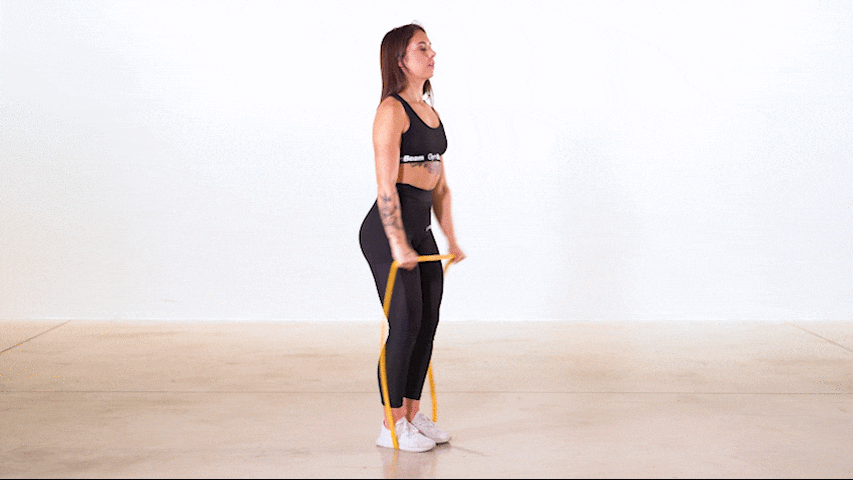
3. Lateral Arm Raises
- Starting position: Place the long expander on the floor and stand it with one leg (split stance). Then grab the ends of the expander and straighten your body. Hold your arms close to your body, the elbows point towards the body, and the elbows are slightly bent. Keep your back straight, head in line with the spine, and shoulders back and down.
- Performance: Activate your arms muscles and raise your arms while exhaling. The elbows should be higher than the shoulders in the upper position. Then carefully return to the starting position while inhaling and move on to the next rep.
- Common mistakes: A small range of motion, uncontrolled movement, bent back, the elbows are too bent.

4. High Pull
- Starting position: Place the long expander on the floor and step one end. Stand with feet hip-width apart. Grab the other part of the band with both hands, straighten your body and raise your arms. The palms point to the body. Keep the back straight, head in line with the spine, and shoulders back and down.
- Performance: Activate your arm muscles, bend your elbows, and pull the band over the chest while exhaling. Try to get the elbows above the shoulder level in the upper position. Then carefully return to the starting position while inhaling and move on to the next rep.
- Common mistakes: A small range of motion, uncontrolled movement, bent back.
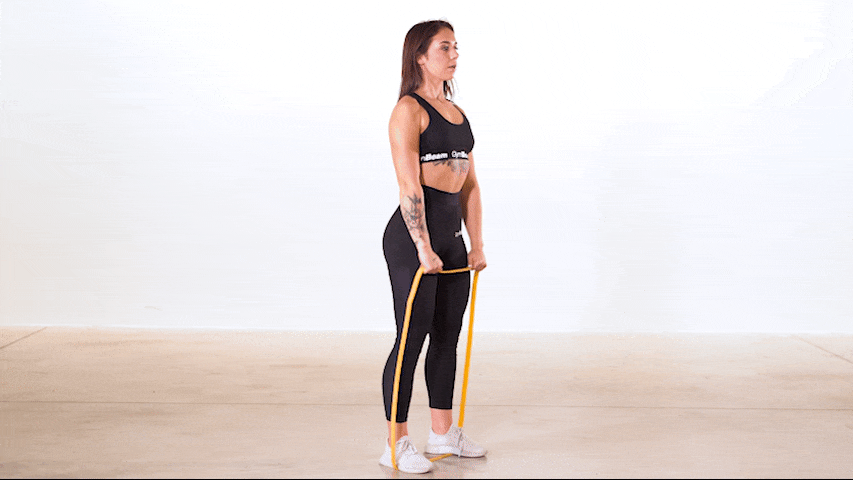
5. Seated Rear Delt Fly
- Starting position: Sit on the plyometric box or workout bench. Place the long expander under the feet (they should be in the middle of the expander). Bend forward and grab the ends of the expander. Keep your back straight, head in line with the spine, and shoulders back and down.
- Performance: Activate your arms muscles and raise your arms while exhaling. The elbows should be higher than the shoulders in the upper position. Then carefully return to the starting position while inhaling and move on to the next rep.
- Common mistakes: A small range of motion, uncontrolled movement, bent back.
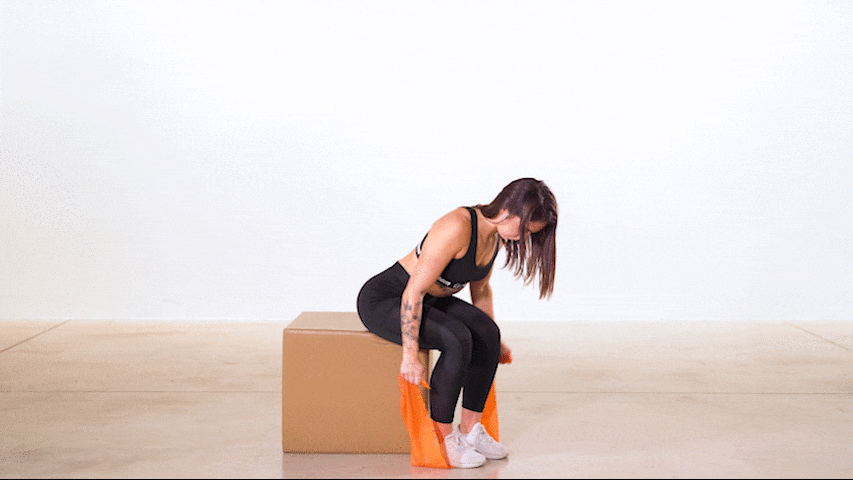
Arm Exercises (Triceps and Biceps)
You can also use the resistance bands for the arm workout. You will target your biceps and triceps.
1. Kneeling Biceps Curl
- Starting position: Kneel on your left leg, extend the right leg forward and bend the knee 90 degrees. Place the long resistance band under the right leg and grab both ends with your right hand. Then rest your elbow on your right thigh (above the knee). Keep your back straight, head in line with the spine, and shoulders back and down.
- Performance: Pull the palm to the shoulder by contracting the biceps while exhaling. Return the arm to the starting position while inhaling and repeat the movement. Once you complete one set on one arm, change sides.
- Common mistakes: A small range of motion, uncontrolled movement, bent back.
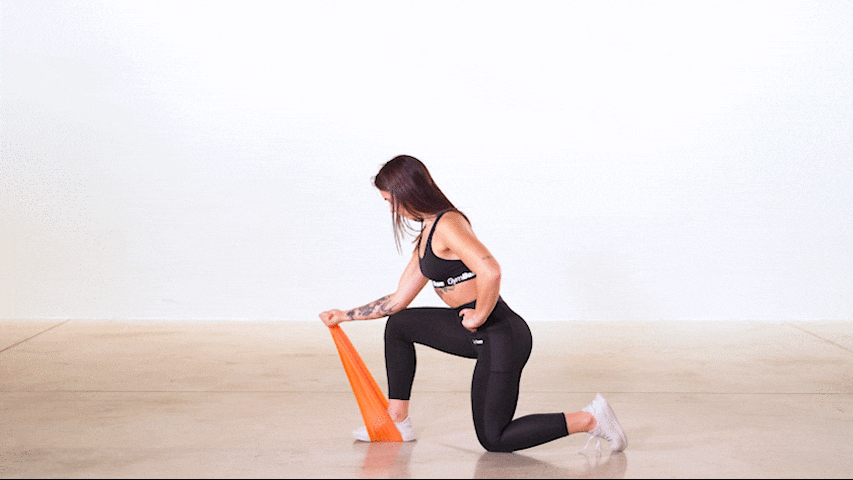
2. Standing Biceps Curl
- Starting position: Step on the middle of the resistance band with one leg with feet shoulder-width apart. Grab both ends of the expander, straighten your body and hold your arms close to your body. The palms point to the front. Keep your back straight, head in line with the spine, and shoulders back and down.
- Performance: Pull both your palms to the shoulders by contracting the biceps while exhaling. Return to the starting position while inhaling and repeat the movement. Try to keep the elbows at the same position (close to the body).
- Common mistakes: A small range of motion, the elbows too far from the body, bent back.

3. Triceps Kickbacks
- Starting position: Sit on the ground, slightly bend your knees and attach the long resistance band to your feet. Pull the other end of the expander over your head and lower it to your lower back. Grab the band with your both hands. Then bend your elbows 90 degrees. Lean forward a little but keep your back straight. The head is in line with the spine, and the shoulders are back and down.
- Performance: Straighten your arms by contracting your tricep muscles while exhaling. Return the arms to the starting position and repeat the movement. Concentrate on maintaining the elbow in the same position during the exercise.
- Common mistakes: A small range of motion, the elbows are too far from the body, uncontrolled movement.
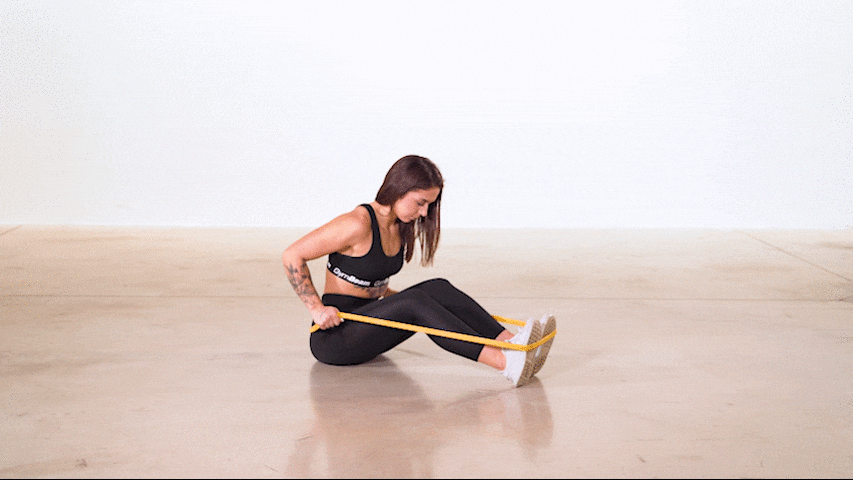
4. Seated Overhead Extension
- Starting position: Sit on the plyometric box or workout bench and attach one end of the expander under your butt. Grab the other end with your both hands and pull them over your back. Stretch your arms upwards and bend your elbows 90 degrees. The elbows point outwards and are behind the head. Keep your back straight, head in line with the spine, and shoulders back and down.
- Performance: Raise your arms upwards by contracting triceps muscles while exhaling. Concentrate on maintaining the elbow in the same position during the exercise.
- Common mistakes: A small range of motion, uncontrolled movement.

You will find other effective exercises for the entire upper body in our article 11 Resistance Band Exercises on the Pull-Up Bar for Strong Arms, Back and Core.
Ab Exercises
You can also effectively strengthen the straight, oblique and lower abdominal muscles with the resistance bands. Enhance your abdominal training with these exercises.
1. Kneeling Crunches
- Starting position: Attach one end of the expander on the upper part of the pull-up bar. Then kneel with your back to the crossbar and pull the band over your head. Hold it in front of your neck with both hands.
- Performance: Lean forward by contracting your abs and slightly round your back while exhaling. Return to the starting position while inhaling and repeat the movement.
- Common mistakes: A small range of motion, uncontrolled movement.

2. Woodchopper
- Starting position: Attach one end of the expander to the upper part of the pull-up bar. Then stand on your left side to the crossbar and grab the band with both hands. Raise your arms in front of your head to the left side and rotate the whole torso in the same direction. Stand with your feet wider than shoulder-width. Keep your back straight during the whole time.
- Performance: Pull the band toward your right knee by contracting your abs while exhaling. At the same time, slightly bend your knees and rotate the whole torso in the same direction. Return to the starting position while inhaling and repeat the movement. Once you complete one set, turn your right side to the crossbar and do the exercise to the other side.
- Common mistakes: A small range of motion, uncontrolled movement, bent back.
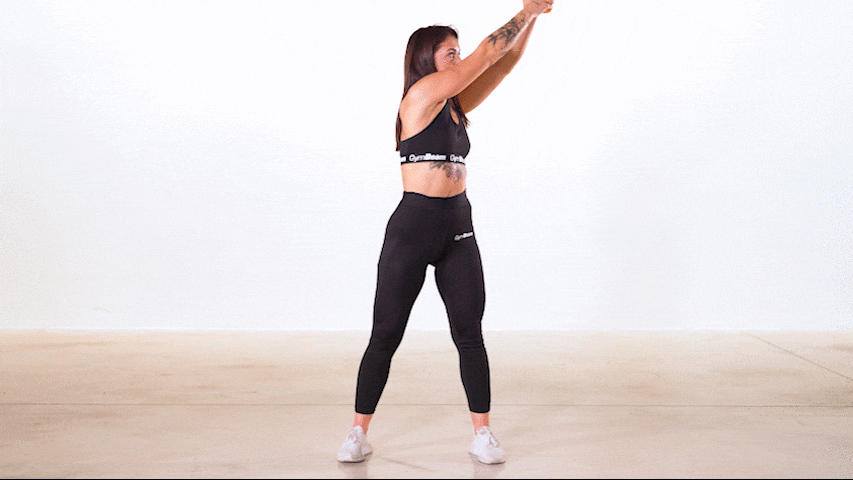
3. Anti-Rotation Walkouts
- Starting position: Attach one end of the expander to the crossbar. It should be stretched (evenly with the ground) at about the height of your biceps. Then stand to the crossbar with your left side, grab the band with both hands in front of the chest and bend your elbows 90 degrees. The expander should not be stretched to the maximum. Slightly bend your knees and stand with the feet wider than shoulder-width. Keep your back straight, head in line with the spine, and shoulders back and down. Engage your core.
- Performance: Inhale and take a step to the right. Then return to the starting position while exhaling and move on to the next rep. Once you complete one set, turn to the crossbar with your right side and perform the same exercise on the other side. The farther you are from the crossbar, the more demanding the exercise becomes.
- Common mistakes: A small range of motion, insufficient core activation, uncontrolled movement, bent back.

4. Reverse Crunches
- Starting position: Attach one end of the expander to the pull-up bar. Then sit on the floor with your head facing the pull-up bar and attach the other end of the band to both feet (hook on the insteps). The expander should be stretched in this position. Lie on your back with your arms alongside the body. Raise your legs and bend your kneed 90 degrees.
- Performance: Raise your pelvis and pull your knees towards the chest by contracting the abs while exhaling. The upper back remains on the mat. Return to the starting position while inhaling and repeat the movement.
- Common mistakes: A small range of motion, uncontrolled movement.
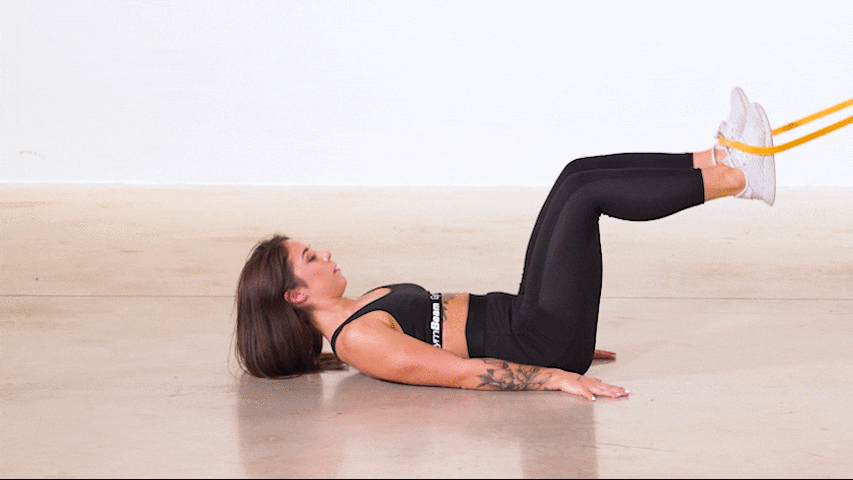
5. Russian Twist
- Starting position: Sit on the floor, slightly bend your knees and hook the long resistance band to the feet. Grab the other end of the expander with both hands and hold it in front of your chest. Bend your elbows 90 degrees. Tilt yourself back a little but keep your back straight. The head is in line with the spine and the shoulders are back and down. Brace your core.
- Performance: Draw the band to one of your hips while exhaling and move on to the next side while inhaling. Try to keep the back in the same position.
- Common mistakes: A small range of motion, uncontrolled movement, bent back.
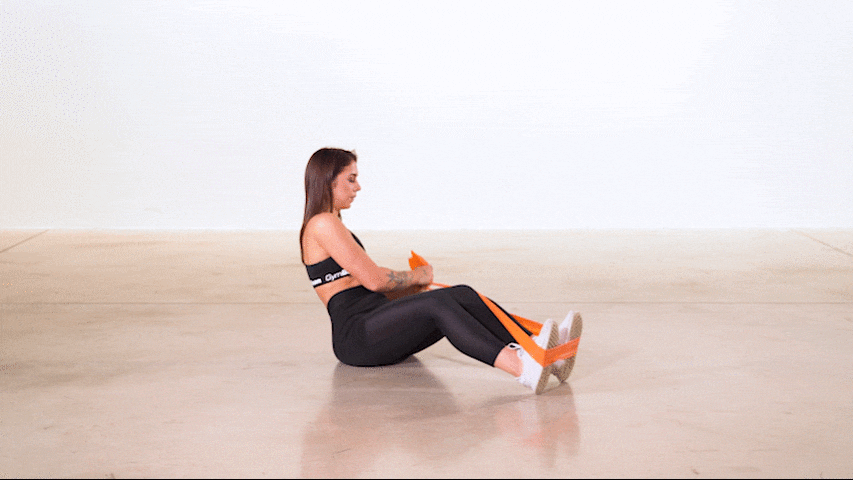
- For more inspiration on ab exercises, see our article Top 9 Exercises to Tighten Your Abs with a Resistance Band.
- You will find all-embracing instructions for a slim belly in our article Lose Belly Fat Get Into Shape with Our Simple Guide.
Sample Full-Body Resistance Band Workout
For this training, choose resistance bands with resistances according to your performance. You can also change them according to how difficult the individual exercises are for you. Or proceed by taking the first set as a warm-up and using a thinner band. You will then perform the others with a thicker band, presenting a bigger load. Only in this way will the training be effective and demanding enough.
Full-Body Resistance Band Workout
Exercise | Number of reps | Number of sets |
|---|---|---|
| Front Squat | 12–16 | 2–4 |
| Hamstring Curl | 8–10 reps on each side | 2–4 |
| Standing Leg Abduction | 8–10 reps on each side | 2–4 |
| Bent-Over Row | 8–10 | 2–4 |
| Standing Fly | 8–10 | 2–4 |
| Push-Ups | 8–10 | 2–4 |
| Overhead Press | 8–10 | 2–4 |
| Kneeling Biceps Curl | 8–10 reps on each side | 2–4 |
| Seated Overhead Extension | 8–10 | 2–4 |
| Russian Twist | 16–20 reps in total (changing the sides) | 2–4 |
Full-Body Resistance Band Workout
You will also find inspiration for resistance band at-home exercises in our training video. You will only need a long resistance band and 12 minutes.
What should you remember?
Resistance band exercises are suitable for everyone who is just starting to work out. However, advanced athletes can also use them in their training plans. Our instructions will help you perform them. You can create your full-body training or work out according to our mentioned above. For visible results, include a resistance band workout at least twice a week. But don’t forget that a balanced diet and enough rest are also crucial for your fitness goals.
Was this article helpful to you? If so, send it to your friends and inspire them to try our resistance band workout.


Add a comment